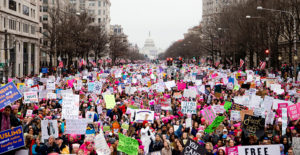Women’s March: 2020 Reflections and 2021 Forecast
 Photo by Vlad Tchompalov on Unsplash
Photo by Vlad Tchompalov on Unsplash Reports on the Women’s March usually focus on the number of attendees and the weather. Yes, it was cold, but I knew I had the freedom to leave whenever I wanted to, unlike, say, many incarcerated pregnant women restrained by shackles. I knew that I could stay as long as I wanted to, unlike women with controlling and abusive partners. I knew that in a few hours I could get a warm meal indoors, unlike the growing population of homeless women and families. I could relax in my apartment with my mom (who visited for the march), unlike the detained migrant families separated indefinitely. Even though I was out in the snow and rain, I knew that if I got sick I could miss work because I’m fortunate to have a job that provides me with good, science-based healthcare.
I can’t tell you how many thousands attended the fourth annual Women’s March in Washington, DC, on January 18 (or in other cities around the world), but I can tell you how much we supported each other. We helped groups stay together. We passed out hand warmers. We shared and held signs and supported impromptu chants and songs. We directed people to food and drink. We appreciated each other. Together we faced the vile pro-life protesters telling us we were evil women who needed to repent. Together we sang and danced to the protest anthem “Un Violador En Tu Camino” (“A Rapist in Your Path”) in solidarity with victims of sexual assault around the world demanding justice.
And together we will vote. Although the Women’s March was born in response to the 2016 presidential election, the issues it addresses began before the Trump administration and exist on every level of society. They will not be completely or permanently resolved with the 2020 election nor with an annual march. But I’m confident that we are able to work towards a more inclusive and empathetic future together.
—Emily Newman, Education Coordinator
At this year’s fourth annual Women’s March, the short lineup of speakers began with a land acknowledgement by Hope Butler from the Piscataway Nation and included remarks from the descendants of Martin Luther King Jr. The flash mob-style choreographed protest song was a welcomed, conscious choice by the event organizers to incorporate intercultural awareness of sexual violence against women. But even though the English translation was offered to participants first, I think some marchers felt awkward or unsure about the song and choreography, and so the meaning of the exercise was lost on a lot of people. In 2021, I would like to see a clearer understanding and acknowledgement of intersectional justice on the part of event organizers and participants.
I don’t blame critics of the Women’s March, many of whom are in my peer group and among my closest friends, for deciding not to participate in recent years. Attempts to make the march feel inclusive can often feel performative. It’s similar to when an organization has people of color on a panel for public-facing events but isn’t doing the hard work on the inside to train its staff to be aware of microaggressions and biases.
The Women’s March needs to be even more inclusive of transgender women, women of color, and to differently abled women and allies. Leaders in these areas should be invited to speak and otherwise participate in the march. If these activists are unwilling to be more involved, there’s likely more work that needs doing to build a feeling of trust between the organizers of the march and activists who have been working on these issues long before 2017.
There’s also the logical question many have asked: “How will my participation in the Women’s March lead to real change?” My answer is that while our political activism often happens in siloed communities, the Women’s March can have a wider scope. Our participation in our local political party committees, for example, doesn’t offer the same visual of women descending upon our nation’s capital with a clear message of fighting for women’s issues, which are people’s issues: unencumbered reproductive health care; policies responsive to alleviating and adapting to rapid climate change; and humane treatment for immigrants, among others.
I look forward to continuing to make efforts to fight for all women’s rights and bring more non-white women onto the stage and into the streets. We can only do that by being sincere in our outreach and demonstrating commitment to fight the other 300-plus days until the next Women’s March.
—Isabelle Oldfield, Paralegal
